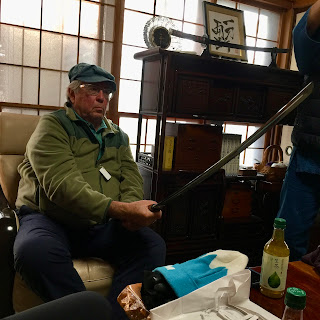(You can read about Day 1 here.)
We left the hotel at 6:30 am to walk to Mishima Taisha Shrine for Dondoyaki, a traditional Japanese event held here on January 15th. People bring their new year decorations, daruma, omamori, and other items to burn them and send them off to the new year gods with gratitude. These events are held at shrines and other places all over Japan after the new year. This is a large shrine with a large burn pile.
I think this procession is the priests and people in charge of the event. There were also firefighters ready, just in case things got out of hand.
Our tour staff gave us each a long bamboo pole with mochi covered with foil to toast in the fire. I was imagining it to be like toasting marshmallows over a campfire, but the fire was too big! Instead the mochi sticks were laid in the coals as it burned down a bit.
After they were toasted, we pulled them out and ate them!
What a delicious treat!
After this, we walked back to our hotel, ate at the hotel breakfast buffet, checked out, and were off again. We first walked through Rakujyuen Park and continued on to the Genbe River.
Our guide Tony explains everything and keeps us moving!
This board shows the changes over the years to the Genbe River and how it is back to being the clean river it once was.
This is dedicated to the construction worker.
The water is now crystal clear, and the Baikamo plant is back and healthy now that the stream is clean again.
These photos were taken on the grounds of the Sano Museum.
Kato Kagetaka receiving a scroll from Minamoto no Yoritomo during the battle of Yamagi (1180)
Next, we went back to the Mishima Taisha Shrine.
Mishima Taisha: Worship and visit Reikishi no YakataMuseum Mishima Taisha enshrines two Shinto gods: Oyamatsumi and Kotoshironushi, collectively referred to as Mishima no Daimyojin. Oyamazumi is the guardian deity of mountain forests and agriculture, and Kotoshironushi – also known as Ebisu – is revered as a god of good fortune. The shrine dates from the earliest period of Japanese history.
Minamoto no Yoritomo prayed here during his exile for the revival of the Minamoto clan. Following his victory against the Taira clan and establishing the Kamakura Shogunate, the shrine became more revered. It is on the Tokaido and is the start of the central Izu road to Shimoda.
Here we had the ceremony and prayer again.
I was a little uncomfortable with the Shinto prayer/blessing ceremonies during the trip, but I decided it was like going to the Catholic church and not taking communion because I'm not Catholic. I can still go to the church.
We had lunch at Enfrance in the Hotel Shomeikan. It was wonderful and I will have a post in a few days with photos about hotels and meals on the trip.
Next stop was the Mishima Lunar Calendar Museum. I thought this place was extremely interesting, but I might have been the only one in our group who thought so. Admission to the museum is free and it is located very close to Mishima Taisha Shrine.
After that, we walked to Sadahito Enomoto Japanese Sword Forging.
Japanese warrior culture was guided by the ethical code of bushido, emphasizing loyalty, honor, and self-discipline. The katana, a curved single-edged sword, became the iconic weapon and symbol of the samurai. These meticulously crafted blades, made from high-carbon steel, required months of skilled craftsmanship and were considered the soul of a warrior.
Sadahito Enomoto is a swordsmith living in Mishima City. He was born in 1954. He studied sword smithing under his father Sadakichi. Sadahitohas been awarded many prizes at the New Sword Exhibition and other competitions.
FROM THE BOOK ” THE NEW GENERATION OF JAPANESE SWORDSMITHS “
Enomoto Sadahito
Craft: Tosho (swordsmith)
Born: 1954
Address: Mishima City, Shizuoka Prefecture
Enomoto Sadahito is the son of Enomoto Sadayoshi. He began training under his father while an elementary student, and became a licensed smith in 1977. He specializes in the Soshu Den, making swords in the tradition of Masamune and Sadamune. He also works in the Gassan tradition, making the trademark ayasugi hada.
He uses tamahagane as well as old steel and oroshigane. He makes swords using the kobuse or makuri construction. True to the Soshu Den, his hamon is a midare with profuse nie, sunagashi, kinsuji, and other hataraki.
Sadahito was invited to demonstrate his craft in 1998 at the University of Wisconsin Art Faculty’s Traditional Japanese Metalwork Seminar. He is currently the President of the Tokai Branch of the National Association of Swordmakers.
Sadahito is a regular entrant in the yearly sword making contests; he has taken the Doryoku Sho, or Effort Award, three times. He is an up and coming smith with great potential; surely his future is a bright one.


























































4 comments:
what an interesting post. All the photos are wonderful but I'd be especially intrigued by the festival and roasting mochi over an open fire! QUITE the fire, too! I'm really enjoying following this!
Although solitary walks and self-education can be very rewarding, joining a group with a comprehensive itinerary and professional guides will take you to places and events you can not reach by yourself.
You found a great tour!
I think this post has almost all the things Japan is famous for: interesting traditions, yummy food (I didn't know toasted mochi was a thing), culture, people dedicated to their crafts, AND people getting together to clean up the environment!
I think it was a fun experience to participate in ”Donto-Yaki“ and bake and eat rice cake. I have been to the Sano Museum to see the KATANA.
Was the KATANA heavy?
Post a Comment